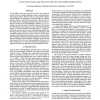Free Online Productivity Tools
i2Speak
i2Symbol
i2OCR
iTex2Img
iWeb2Print
iWeb2Shot
i2Type
iPdf2Split
iPdf2Merge
i2Bopomofo
i2Arabic
i2Style
i2Image
i2PDF
iLatex2Rtf
Sci2ools
ISBI
2007
IEEE
2007
IEEE
Segmentation of Mammosphere Structures from Volumetric Data
3D cell culture assays have emerged as the basis of an improved model system for evaluating therapeutic agents, molecular probes, and exogenous stimuli. However, there is a gap in robust computational techniques for segmentation of image data that are collected through confocal or deconvolution microscopy. The main issue is the volume of data, overlapping subcellular compartments, and variation in scale and size of subcompartments of interest. A geometric technique has been developed to bound the solution of the problem by first localizing centers of mass for each cell and then partitioning clumps of cells along minimal intersecting surfaces. An approximate solution to the center of mass is realized through iterative spatial voting, which is tolerant to variation in shape morphologies and overlapping compartments and is shown to have an excellent noise immunity. These approximate estimates to centers of mass are then used to partition a clump of cells along minimal intersecting surfa...
Cell Culture Assays | ISBI 2007 | Medical Imaging | Minimal Intersecting Surfaces | first Localizing Centers |
| Added | 03 Jun 2010 |
| Updated | 03 Jun 2010 |
| Type | Conference |
| Year | 2007 |
| Where | ISBI |
| Authors | Ju Han, Hang Chang, Qing Yang, Mary Helen Barcellos-Hoff, Bahram Parvin |
Comments (0)

